Improper care
Newcomers are usually afraid to take the wrong step, which will lead to the death of the culture.
But do not be afraid, in fact, leaving is not very difficult. The main thing is to follow the recommendations and not touch the pot with a flowering plant unless absolutely necessary. Phalaenopsis really does not like familiarity and frequent moves from one window sill to another.
There are several reasons for this phenomenon, if it is not possible to immediately determine the source, then you will have to act by elimination, scrupulously checking all the points of care, paying attention to changes in the state of the flower
Temperature
It is very important to support long-term flowering or to stimulate the flower to form a peduncle. The comfortable level of heat is kept within the range of 22-26 ° C. If the flower is healthy, but does not even think to bloom, it is transferred to a cooler place with a temperature of no higher than 16-18 and kept for at least 2 weeks.
Such a shock drop will lead to the activation of processes in the roots, and watering with a solution of succinic acid stimulates growth and the beginning of flowering.
Lighting
The health of the orchid largely depends on its level.
- It quickly reacts to the lack of sunlight by dumping the bulk of the leaves.
- A direct stream of light will burn the plate. The leaf will die or it will hurt for a long time.
The best option is to place a flower on a southern window with covered glasses.
Diffuse tulle or blinds are often used. With a lack of lighting, phytolamps will have to be mounted. Their choice is wide enough, while an interesting decorative effect is achieved that decorates the room.
Dry air
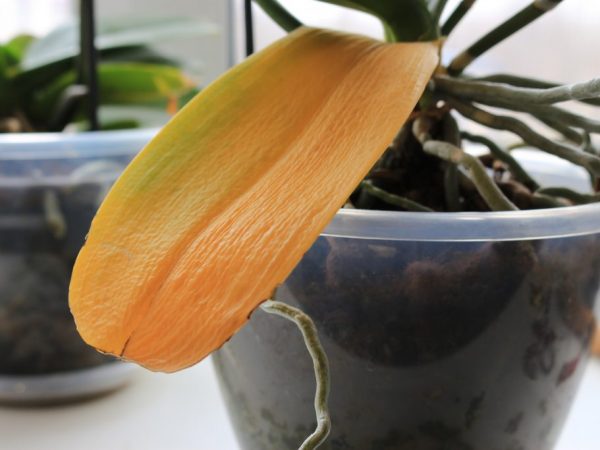
Monitor the humidity of the air
The orchid feels good with a humidity indicator of 60-70%, which is unacceptable for residents of an apartment or private house. Automatic systems for maintaining a microclimate are installed in greenhouses; at home, you will have to be content with daily spraying from a spray bottle with warm, settled water.
The flower is very fond of showers, but then it must be left in the bathroom until the leaves naturally dry. Microscopic drops on the plates provoke sunburn.
When the air is too dry, the orchid sheds its leaves to reduce the loss of moisture; when the parameters acceptable for it are restored, new leaves begin to form.
Watering
All types of orchids are epiphytes, receiving water not from the soil, but from the environment. Therefore, watering in the usual sense of the word is not carried out for them. Waterlogging of the roots leads to their decay, and falling on a leaf outlet provokes the discharge of buds and yellowing of the leaves.
To avoid negative consequences, it is worth adopting a very convenient way. When the earthen coma dries out, the pot is simply placed in a pan with water for several hours. Through the holes in the bottom, the flower itself will take as much as it needs.
Fertilizers
For feeding, use complex liquid or granular preparations for cacti and orchids. Agricola and Good Strength have proven themselves very well.
It is worth focusing on the following features:
in spring, attention is paid to nitrogen as part of complex dressings;
in summer, the frequency of fertilization is 2 times a month;
when the first bud appears, root feeding is completely stopped;
during flowering, only foliar support is carried out by spraying on the leaves;
during the dormant period, fertilizers are not applied.
Instructions for action
When only foliage falls
Many novice florists are worried about the question of why all the leaves fell off, but the roots are still alive? When the green mass falls from the plant, you should not panic. First, you need to figure out why the leaves turned yellow and fell off. Perhaps it's the aging of the flower. If not, then closely examine the beauty, which parts also look unhealthy. Then proceed to the following steps:
- revise the features of care;
- move the flower to partial shade;
- exclude watering with tap water;
- move the flower away if cordilina, yucca, peperomia or araucaria are in the neighborhood;
- during the first two weeks, do not fertilize, and then with weakly concentrated preparations based on nitrogen, for the intensity of the growth of young shoots;
- inspect the orchid for small parasites or infections, if the reason is urgent to take action;
- treat the plant with special chemicals;
- change the pot if necessary;
- update the soil.
When the flowers also fall
Improper care of the plant at home can lead to the question of why the flowers turn yellow and fall? One of the reasons may be a lack of fluid, which can occur when there is no watering at all. The plant needs a minimum volume of water, which dissolves the minerals in the soil and nourishes the root system. This is the reason why the leaves turn yellow, dry up and fall, as well as dry flowers. Measures taken:
we remove the orchid from the flowerpot;
immerse in a basin of water until the earthen coma becomes dehydrated (note that water should not get on the leaves);
if necessary, place in a new pot.
Similar symptoms indicate overfeeding of an exotic beauty with mineral fertilizers. Then we carry out the same activities, and no nutrients should be added for 2-3 months.
When the roots disappear
This condition, unfortunately, is quite common. When, when the leaves fall, the root system also dies (we talked about whether it is possible to save an orchid without roots and leaves and how to do this, we talked about here). If all the leaves of the plant have already fallen off, and the process has begun when the roots disappear, then there may be several reasons. This is possible when the soil is waterlogged, when the liquid stagnates in the flowerpot, and the leaves and roots rot. Or with fusarium wilting caused by mold fungi (read here how to save an orchid from mold, and from this article you will learn how to understand that a bay has occurred and how to save a plant).
If symptoms are found, you should:
- disinfect the trimming tool;
- get the flower out of the pot;
- soak the roots in warm, clean water;
- carefully examine and feel all the roots;
- trim off damaged, soft, dry areas with a cooked, sharp tool (read more about why orchid leaves have become sluggish and how to fix this problem, read here);
- treat the sections with an antiseptic that does not contain alcohol (ground cinnamon, powdered activated carbon);
- to destroy or to prevent infections, treat the flower with a fungicide;
- place the orchid in a new pot, it should be transparent and slightly cramped;
- mandatory presence of a drainage layer;
- sprinkle the plant with new soil enriched with minerals;
- you can fertilize after 2 weeks;
- optimize growing conditions, because it is possible to revive a flower only in a favorable environment.
When all the foliage has fallen
It happens that the plant has dropped all of its green mass, while the root system is alive and green. In this case:
- we remove the orchid from the flowerpot;
- we clean it from soil;
- leave the roots in water for a couple of hours to replenish with liquid;
- we examine the root system, foliage for the presence of harmful insects;
- we also cut dry leaves to healthy tissue;
- we disinfect the places of the cuts;
- after the wounds have dried, we place the flower in a pot with new soil;
- we treat living kidneys with cytokinin ointment;
- use nitrogen fertilizing 1 time in 7-10 days.
The ideal option is quarantine:
- Move the plant to a warm place with diffused sunlight.
- Monitor watering frequency and water quality.
- Minimize water procedures.
- Also carefully monitor the further condition of the orchid.
Prevention measures
After studying the causes of plant disease, it is imperative to develop a number of preventive measures that will subsequently help to avoid further mistakes and prevent them from reappearing. To do this, you need to follow the following rules.
You need to fertilize the orchid only with those compounds that are sold in specialized stores.
It is important that their concentration is minimal. In addition, fertilization is not recommended at all for the first few months.
Water the flower with clean water
It can be distilled, boiled, or well-filtered liquid.
It is imperative to monitor the change of soil, while you need to buy it in flower shops.
Observe the temperature regime. The temperature should not be lower than 15 degrees and not higher than 25.
Don't forget about proper lighting and buy good and powerful lamps that are fixed to the ceiling or windowsill.
The container purchased for the orchid must be appropriate. That is, it must be transparent so that the roots are constantly illuminated.


Summing up, we can say that you can cope with the problems that arose when caring for an orchid at home. In addition, you should not immediately panic if the leaves begin to fall off, because this can happen naturally, and this situation will not be reflected at all on the flowering of the orchid. In just a few months, the pet will delight the household with its flowers and fresh green shoots.
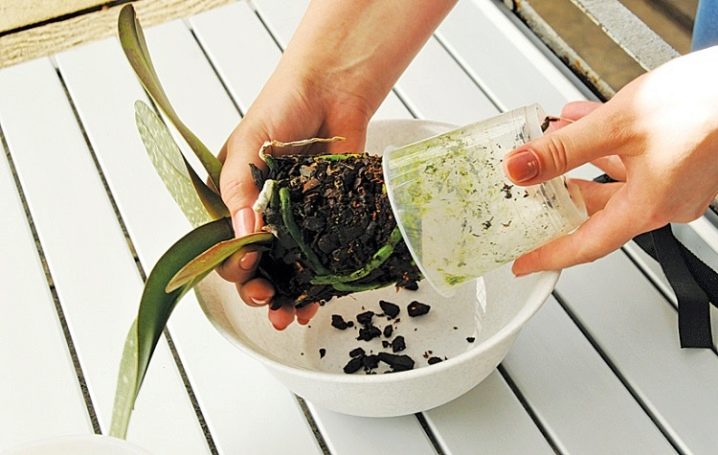
You can learn more about how to reanimate an orchid without leaves and a growth point.
The main reasons why Phalaenopsis buds fall
The answer to the question of why buds fall on an orchid is quite simple. This is non-compliance with the conditions of keeping and growing. Any discrepancy between the microclimate in the house and the one that the orchid requires can lead to such sad consequences as the loss of buds and flowers. Let's dwell on each aspect in more detail.
Low humidity
Although phalaenopsis does not require high humidity, and it feels comfortable at 40-50%, a drop in air humidity below this mark will lead to a deterioration in its well-being.
Outwardly, it is not immediately possible to determine the cause, since the plant does not fade sharply. However, the process of dropping the buds will be almost impossible to stop.
As a rule, this happens during the heating season, when the heaters evaporate all the moisture from the air. This leads to the fact that the flowers of the orchid fall. Therefore, in winter, it is recommended to additionally humidify the air by any available means: humidifiers, containers with water, spraying.
Violation of the watering regime
Lack of watering is a fairly common reason why orchid buds fall off. But it is worth noting that, unlike a lack of moisture, the need for watering can be diagnosed rather quickly. The measures taken in time will save the flowering and preserve the remaining buds.
The appearance of the plant is visible when it needs urgent watering. The leaves are not very attractive. They become dull and dry out. The buds and flowers themselves lose their elasticity and become softer to the touch. You can notice that they begin to hang, look not in the direction of the light, but down.
In this case, you urgently need to water the plant. Place the pot in a container of water for at least 30 minutes. Then you can spray the leaves. After that, immediately return the flower to its usual place. If the measures were not taken too late, then the flowers will be transformed again and become fresh.
Lack of lighting
Phalaenopsis orchids are demanding on the amount of light and the length of daylight hours. In low light, they simply won't bloom. With an increase in daylight hours by at least 1-2 hours, the flower understands that it is time to start blooming. However, if daylight hours ended up being less than 12 hours and does not increase further, then flowering will stop.
This will serve as a signal for the phalaenopsis that the time for flowering has not come, and he will shed the buds. This behavior can be difficult to predict. Therefore, it is better to make sure in advance that the light comes to the flower for at least 12-14 hours in a row.
Temperature violation
With slight or short-term temperature drops, the orchid does not shed its buds. But if the room was stable at +23, and then you decided to lower the temperature there to 19 degrees, and it stays at this mark all the time, then the flower will most likely consider that the warm season is over and it is time to prepare for the resting phase.
The temperature for resting phalaenopsis is about 18 degrees. That is, the closer to this mark, the higher the risk of stopping flowering.
But even very high indicators do not bring benefit to phalaenopsis. Already at 30 degrees, the process of wilting of flowers begins
So it is important to find the optimal temperature and maintain it constantly.
Drafts
Sometimes the reason why an orchid drops flowers is not at all clear. It seems that the conditions are good and stable. But suddenly, the buds begin to fall off.
You need to understand that Phalaenopsis is a rather capricious and wayward plant. There is no direct connection between a draft and bud fall. However, the flower may not be comfortable - the air may be too cold, or vice versa, too hot. As a consequence, flower loss is possible. But it's worth noting that this is a fairly rare reason.
Aging
It may be that the orchid has grown old and its energy reserve is not enough to complete the flowering stage. The situation is quite unusual, since with proper care, timely transplants and treatments, this can be avoided.
Stress from changing conditions
Unblown buds often fall off if the conditions for keeping the flower are changed. It is not uncommon to observe how flowers fall from a recently purchased plant. And the reason for this is usually the change of scenery.
This can be avoided by providing the flower from the first day with excellent care and a microclimate as close to natural as possible.
It is also undesirable to rearrange the flower inside an apartment or house. If you want to do this, then you need to wait until the flowering is complete and the transition to the resting phase.
But this often happens when you want to put a blossoming flower in a more prominent place. And the result is the opposite - after a few days he loses all flowers and buds.
Resuscitation methods for diseases
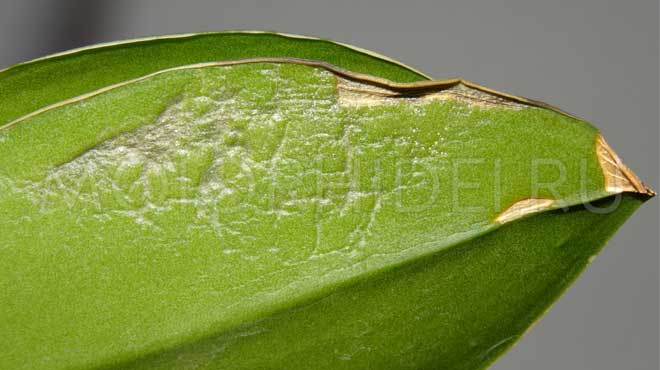
If, as a result of improper location and lighting, the health of the orchid was threatened, the leaves turned yellow, the roots atrophied, then, first of all, they quarantine in the shade, cut the atrophied roots, rub the cuts with coal and organize watering by immersion. After these procedures, the location of the flower is changed.
- With improper care, fungal diseases occur, and bumps form on yellowed leaves. Treatment is carried out with solutions of fungicides and sometimes removal of diseased parts of the flower.
- Bacterial stains. Usually old leaves are affected, which must be removed, and the sections are treated with charcoal and bactericidal preparations.
- Root atrophy. The roots have dried up and are no longer able to perform their functions. Phalaenopsis resuscitation, for example, is performed by separation and transplantation. They urgently change care, temperature regime and location. It is also characterized by dried leaves.
- Putrid disease (root rot). The wrong regime of humidity, watering and temperature can lead to this disease. The flower can look healthy for a long time, although putrefactive lesions are already developing.Resuscitation will help to save the orchid, which is carried out by cutting off rotten parts and an urgent transplant with mandatory quarantine for a week.
Follow-up care
Depending on the scale of damage to the orchid, the duration of its recovery period will also depend. This can take from six months to a year, so you should be patient and take care of the plant in such a way as to facilitate its recovery period as much as possible and resume all life processes. In order for the flower to develop faster, you can wipe the leaves with a solution that activates and accelerates growth. For optimal results, it is sufficient to do this 1-2 times a week.
It is better to restore the orchid in the warm season. In winter, the healing procedure takes longer. Depending on the problem that you had to face, you may need to transplant the flower into a new container. It is best to grow your orchid in a pot that is suitable for the size of the particular plant.
Planting in pine bark is considered the most acceptable option, since it:
- makes the soil breathable;
- is moisture-absorbing, makes it possible to remove excess moisture;
- has an antiseptic effect due to lignin;
- it contains a lot of nitrogen, ash and oxygen, wax, vegetable fats and other trace elements and mineral acids.
Growing
Growing the most amazing orchid plant on the planet at home is an interesting and painstaking task. Given that this flower naturally lives in a tropical climate with high humidity, good lighting and warm air temperatures, it is necessary to bring home conditions closer to these requirements.
These unique plants grow well at home in places with good natural or artificial light. When placing a flower on a windowsill, it is necessary to ensure that direct sunlight does not fall on it, which can cause burns. It is better to choose windows on the east or west side. In summer, it is advisable to protect the flower from the bright sun with a special plant net. If the flower is located in the back of the room, then it needs artificial lighting for 12-14 hours. Usually a fluorescent lamp or phytolamp is used.
For the proper development of the plant, the temperature regime is important. It is advisable to maintain the temperature all year round within the range of +18 ... + 28 degrees Celsius. In winter, it is necessary to monitor the changes in night temperatures in the plants on the windowsills. The norm is in the range of 4 -5 degrees Celsius, a larger gap between temperatures can contribute to flower disease. In the summer during a drought, the plant needs systematic irrigation.
It is important to pay attention to the watering regime. Usually watered twice a week, as the soil dries. With excess moisture, putrefactive processes occur, contributing to plant diseases and attracting pests
Periodically, it is required to introduce top dressing, taking into account the phase of plant development and seasonality. In the winter and summer periods, fertilizers are applied no more than once a month, and in the spring and autumn periods, once every two weeks, if the plant does not bear flowers.
With excess moisture, putrefactive processes occur, contributing to plant diseases and attracting pests. Periodically, it is required to introduce top dressing, taking into account the phase of plant development and seasonality. In the winter and summer periods, fertilizers are applied no more than once a month, and in the spring and autumn periods, once every two weeks, if the plant does not flower.
Top dressing is recommended to be introduced when the flower is at rest. It is better to choose specially designed fertilizers for this type of indoor flowers. In the phase of active vegetation, phosphorus and nitrogen-containing substances are used, which help to improve the process of photosynthesis, protein and carbohydrate metabolism.At the beginning of flowering, when the first peduncle appears, dressings containing phosphorus and potassium are applied. This has a significant effect on the formation of flower stalks and buds. You can fertilize by root and foliar (leaf) method.
How to propagate with roots?
Orchid propagation can be done in different ways. However, it is imperative that you familiarize yourself with the basics. Young plants should not be used as they will be difficult to separate. In addition, a young plant may even die. You can do everything right either with peroxide or with a solution of potassium permanganate.
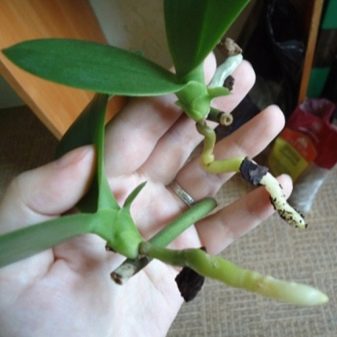
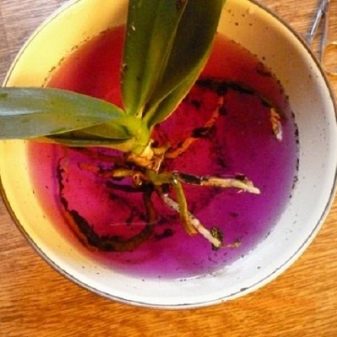
Through the roots
Separation is allowed only half a month after the orchid has faded. When dividing, all the roots must be absolutely healthy, and on each of the divided parts there must be several pseudobulbs (at least two). The more there are, the more successful the division will be, which means that the plant will be able to take root faster.
The first thing to do is to get the orchid out of the pot and clean it of soil. To do this, you can gently shake the plant, and the excess substrate will disappear by itself. Next, the roots of the orchid should be placed in water heated to room temperature. They should be there for about half an hour. Then, using a very sharp knife, you need to cut the root, and then divide the orchid into two parts.
The cut areas should be sprinkled with either ground cinnamon or powdered activated carbon. Then the plant must be left for 2-3 hours so that the roots dry out a little. After that, both divided parts can be seated in separate pots, with soil prepared in advance. It can be with or without sphagnum moss.
Having transplanted an orchid, you need to closely monitor it. Watering is best done by spraying.
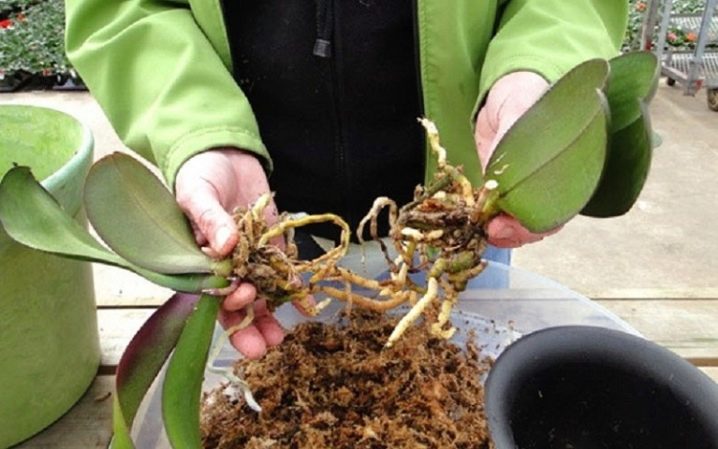
Air shoots
Orchids also reproduce by air. If the flower has many silvery aerial roots, then they can be used for reproduction. For this purpose, you need to choose the strongest of the roots that appear and carefully, without cutting off from the stem, put on a layer of moss in the same pot. Before this, the moss must be slightly moistened. Then a small incision must be made in the root and treated with a special stimulating agent. A process should appear at the cut site, which will have small roots in a month.
After their appearance, the baby can be cut off from the main plant and sprinkled with cinnamon or charcoal over the cut site. The incision should be no more than one centimeter from the main root. Now you can transplant it into a separate pot, which will be a little smaller. To quickly grow a good root system in a new plant, you can make a homemade greenhouse. To do this, cover the branch with a plastic cup cut from the side and create a greenhouse effect.
Moss must be regularly moistened so that a young orchid can quickly grow and develop.
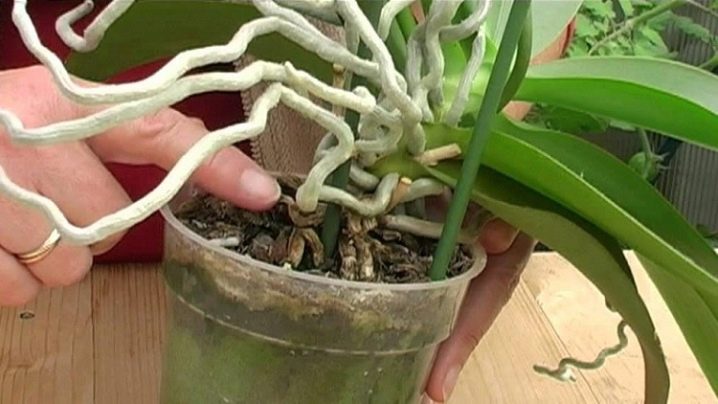
How to care?
Every florist should remember that proper care is the key to the good development of an orchid. If you treat a flower carelessly, it will not be strong and healthy. When the liquid stagnates, the plant rots, with dryness it can also die. It is worth adhering to simple tips from experts.
First you need to choose the right pot in which the flower will be comfortable. A plastic container with transparent walls is most suitable, through which the moisture of the root system will be visible.
Consider where the orchid may be located. Some people make a big mistake and put the plant on the windowsill in front of the window, where there are no curtains. Others put it next to a battery or some other device that heats the room. You need to place the orchid on a stand. Thus, she will not get burned and she will have enough sunlight.
Before choosing a mineral fertilizer, you need to know about the type and needs of the plant.You need to monitor the acidity of the soil, as well as what plants are next to the orchid
It is important to constantly inspect the flower in order to react quickly if it starts shedding leaf plates again. If a grower has acquired a new plant, it should stand apart from the others for some time.
Not too whimsical species and varieties of plants can be watered with warm tap water, which has stood for several days
It is necessary to carefully pour it into another container so that the liquid that is at the bottom does not get into, since it is not recommended to water the plant with it.
Watering rare and whimsical species is necessary with a liquid that has been purified using a filter. This is done to remove salt and soften it. If it is not possible to use a jug with a filter, you can boil the water and then cool it down. In this case, it will also be softer. You can mix water that has settled and distilled liquid in a 1: 1 ratio.
To understand how often a plant should be watered, you need to monitor its growing and dormant periods. Phalaenopsis does not have any clear division into these periods, so such species can be watered once every 7 days. But there are varieties, the dormant period of which can be divided into conditional (one watering in 7 days), pronounced (several waterings in 30 days), as well as dry (no need to water for 30 days).
Water the orchids with a small jug. It must have a spout. If such a container is not available, you can purchase a small watering can. It is necessary to ensure that the liquid does not fall into the outlet, as unaesthetic stains remain in this place, and rot may also appear. Some growers place a container with an orchid in a slightly warm liquid, then raise it and wait until the excess drains.
In summer, it is better to carry out additional spraying of the flower with a sprayer. The sheet plates should be washed with a sponge once every 30 days.



